How should Asheville balance the need for affordable housing with the desire to provide housing in general to fuel revitalization of the River Arts District? That question came to the forefront at City Council this week as it approved a large apartment complex with no affordable units while restricting short-term rentals in the neighborhood.
A new zoning code for the River Arts District that has been two years in the making won approval from the Asheville City Council on Nov. 14, with the stipulation that lodging of 20 rooms or fewer will not be allowed as a use by right in mixed-use districts.
A motion to approve the RAD form-based code with restrictions on whole-house and whole-unit short-term rentals passed 5-2, with Council members Cecil Bothwell and Keith Young opposed. Bothwell had put forth a motion to allow STRs in the new code, but that motion failed to get a second.
Competing visions for RAD
The River Arts District form-based code creates seven new zoning districts specific to the RAD that are designed to foster a mix of development. Its stated intent is to preserve the “industrial and creative arts feel” of the neighborhood, support artist studios and adaptive reuse of buildings, and ensure that future development reflects the community’s vision.
For Council, the key issue in adopting the code was whether property owners can rent entire units for fewer than 30 days, most commonly offered on sites such as Airbnb and VRBO. Such rentals are currently banned as a use by right in all residential districts of the city, and the city is gathering information on how many of them exist in commercial and mixed-use districts.
Council member Gordon Smith pointed out that RAD is not being singled out for a crackdown on short-term rentals. “What’s been moving here on Council is a more broad examination across all the commercial districts, with the RAD going first, and that’s because we’re at this place with the zoning,” he said.
Smith’s comments were met with laughter by some in the City Hall chamber, and he defended the desire to scrutinize short-term rentals in the RAD. “The fact that City Council is saying, ‘Hey, we want to make sure that we aren’t going to squeeze out locals to make room for tourists in one of Asheville’s most popular, attractive, wonderful, places full of so many folks’ is a credible, reasonable perspective, held by thousands and thousands and thousands of people, so dismissing it doesn’t make sense,” he said.
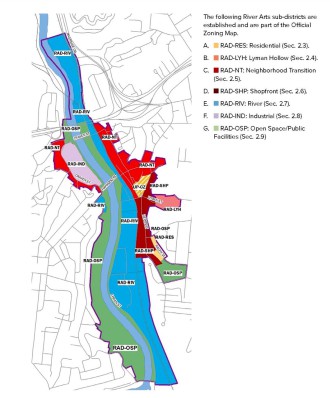
A form-based code places emphasis on defining a building’s form and its relationship to its surroundings, as opposed to conventional zoning, where the focus is on controlling the uses that are allowed within the buildings. That distinction is why Bothwell said he was going to vote against removing lodging of 20 rooms or fewer as a permitted use — because the new code specifically is designed to be based on form, not use.
Several members of the public, including Dee Wiliams and Delores Venable, highlighted an area on Ralph Street and expressed worries that its designation in form-based zoning would cause gentrification and decrease affordability, especially for marginalized communities, and would preclude it from being included in a community land trust at a future date. Mayor Esther Manheimer and other Council members repeatedly assured the crowd that the code would have no effect on the parcel’s ability to become part of a community land trust.
Council member Julie Mayfield responded to concerns that the form-based code could spur gentrification in the RAD. “Asheville is gentrifying because we are super popular. People like to come here and people like to move here, and that’s making it less affordable for a lot of people,” she said. “What a form-based code does is it takes a place that somebody has decided is a special place … and it says we’re going to make a decision about what this looks like as it develops — we the community are going to make that decision.”
RAD resident Rachel Larsen stated her position clearly: “I beg of you, please, just pass the form-based code already so we can get on with making the improvements and adjustments as they need to be made over time.” She pointed out that people who live and work in the RAD have been working with the city and consultants for two years, through several drafts and many meetings, and she’s a bit disappointed about people bringing up last-minute changes.
Hedy Fischer, who owns property on Depot Street, agreed that the process should have been respected. “We spent over two years in meetings with staff to address issues in River Arts District. We came up with what we thought was a good plan,” she said. “Bit by bit it’s being changed without our input.”
Kim Roney asked City Council to consider existing communities that need affordable housing in the area. “The River Arts District form-based code looks like what I hear in the community, the new redlining, the new gentrification. You have to acknowledge why it looks like that,” she said. “Because I know you’ve had a long process of two years going to this, but our city that a lot of us love so much has decades of systems of oppression and systems that are broken by design.”
Parking kept to minimum
After the RAD form-based code passed, most of the members of the public who had come to speak on the topic left the Council chamber. Directly following that exodus, Council moved to the next agenda item, which was to remove the River Parking Reduction Area from the River Arts District. That reduction in required minimum parking spots was adopted in 2011 before RAD began booming, prompting some to advocate for more parking availability in the neighborhood.
City Planner Sasha Vrtunski said the philosophy behind the plan is to ensure the availability of parking doesn’t pose a barrier to development. “We do have to accommodate cars, we do have to make sure cars do not become a problem in our neighborhoods, but at the same time, we are not developing around cars,” she said.
Even eliminating the parking reduction area in the RAD, the new code approved earlier in the meeting still has lower minimum parking requirements than other areas under the city’s Unified Development Ordinance, Vrtunski explained.
Mayfield said she feels the city should go further, and announced she would be voting against eliminating the parking reduction area on principle, even if no one else joined her. “Eventually what I would love for us to do is get rid of mandatory minimum parking requirements here and in other parts of the city like we’ve done downtown, just because we know that is the best way to create the kind of walkable, dense, bike-friendly place that I think we want to build in this city,” she said.
Mayfield was not alone in wanting to discourage car traffic, however. Smith said her comments inspired him to vote against removing the parking reduction, and Bothwell and Young also voted no, leaving Manheimer, Brian Haynes and Vice Mayor Gwen Wisler voting yes. The motion failed, 4-3 — a turn of events at which Council members expressed surprise.
Assistant Planning Director Alan Glines said he would report back to Council if staff ran into any issues with determining parking regulations in the RAD based on the new code existing alongside the current parking requirements.
Council OKs 133-apartment project
Despite the objections of affordable-housing advocates, Council gave the go-ahead to the Stoneyard Apartments complex, approving conditional zoning of the property located at 175 Lyman St. in the River Arts District.
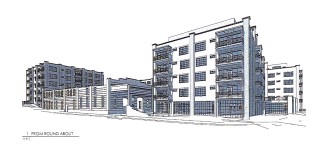
The project will bring 133 apartments, commercial space, a restaurant and a parking structure in five buildings with parking on the ground level due to its location in a floodplain. The 2.88-acre property has served as the site of J.R. Stone Sales and features the Carolina Ice and Coal Building, which dates to 1912 and will be rehabilitated as part of the project.
The applicant asked the city to allow 46 units per acre instead of the 35 permitted in that district. The developer could have been allowed a density of 70 units per acre if it committed 20 percent of the units to be affordable housing, but the developer cited the high costs of building in a floodplain as a prohibiting factor in doing so.
Smith asked developer David LaFave what the monthly rents would be, and LaFave said they are not yet set in stone, but the range would likely be: studio apartments, $750-$800; one-bedrooms, $1,100-plus; two-bedrooms, $1,300-$1,400; and artist studios, $300-$400.
One condition of the rezoning is that the developer give $50,000 to the city’s Housing Trust Fund, which assists in the development of affordable housing. Wisler and Smith told LaFave they would vote for the project if he would up that to $175,000, since he was opting not to include the 20 percent affordable housing element.
Smith pointed out that “fewer than half of Asheville residents would be able to afford to live there” and that approving the project would go against Council’s commitment to affordable housing in the city. “I wonder where we’re going with all of this. And I wonder if there’s going to be room for everyone in Asheville or if there’s only going to be room for those folks who can afford that market rate and those hotel rooms,” he said.
Casey Campfield suggested that Council should ensure the project provide affordable rental rates. “Asheville is experiencing a housing crisis. Low- and middle-income renters are being forced to leave the city in large numbers,” he said. “So it’s surprising and a little disappointing to see a proposal for a mixed-use development for 133 residential units in which exactly zero of the units are designated for affordable housing.”
Some residents of the RAD expressed their support for the Stoneyard Apartments project, saying it would bring vitality to the area. Helaine Greene, an owner of the Riverview Station artist studios, said she was excited at the idea of more people living in the district. “I feel it would just be a real benefit to the community,” she said.
Pattiy Torno, owner of Curve Studios, said she welcomed its addition of 10 artist studios that she sees as affordable. Roney followed up by commenting that although she was thankful for the addition of artist space, she did not see the studios as being within the range of affordability for most artists.
Council approved the Stoneyard Apartments project in a 5-2 vote, with Haynes, Manheimer, Bothwell, Mayfield and Young in favor, and Smith and Wisler against.
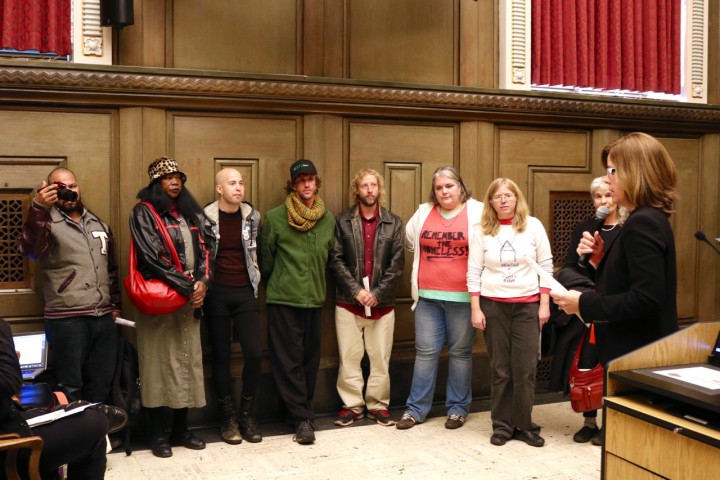
The face of homelessness
Manheimer read a proclamation naming Nov. 11-19 as National Hunger and Homelessness Awareness Week in the city of Asheville and encouraged people to “take action to end homelessness and food insecurity in our city.”
The declaration calls for ending the criminalization of homelessness and recognizing that it is a serious problem for many families and individuals in Asheville. It states that Buncombe County has 500-600 people experiencing homelessness at any given time, and 20 preventable deaths occur each year due to homelessness-related health issues.
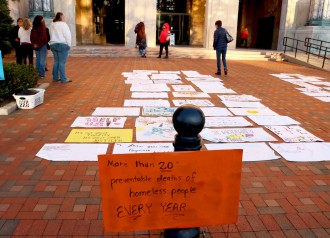
“There are many different reasons our friends and neighbors in Asheville are hungry or homeless, including the shortage of affordable housing for very low-income residents and the presence of food deserts in our community,” Manheimer read from the proclamation.
Amy Cantrell of BeLoved Asheville, a grassroots group working to lift up communities in need, accepted the proclamation and introduced members of the group’s Homeless Voice community to speak.
Joshua Roseman said the group in attendance represented the face of homelessness in Asheville. “We are just some of the people behind the numbers, and there are many of us who could not be here because they had to be in the shelter or had to get to their campsite before dark,” he said. “We are part of the city, we care very much about the city. … We are people just like you — we have dreams, we laugh, cry, and we bleed and die. We are dying on average 25 years before our time, and we believe that we can change that.”
Randy Stoudt said the group wanted people to know they are more than a stereotype. “We are making gardens and free farmers markets for elders, increasing voter engagement and working to be solutions to some of our top city problems,” he said. “In response to the death of Janet Jones, a homeless friend who froze to death in her sleeping back on the river last October, we started the first street medic team in the country made up of people who are experiencing homelessness.”
More information can be found at www.belovedasheville.com.


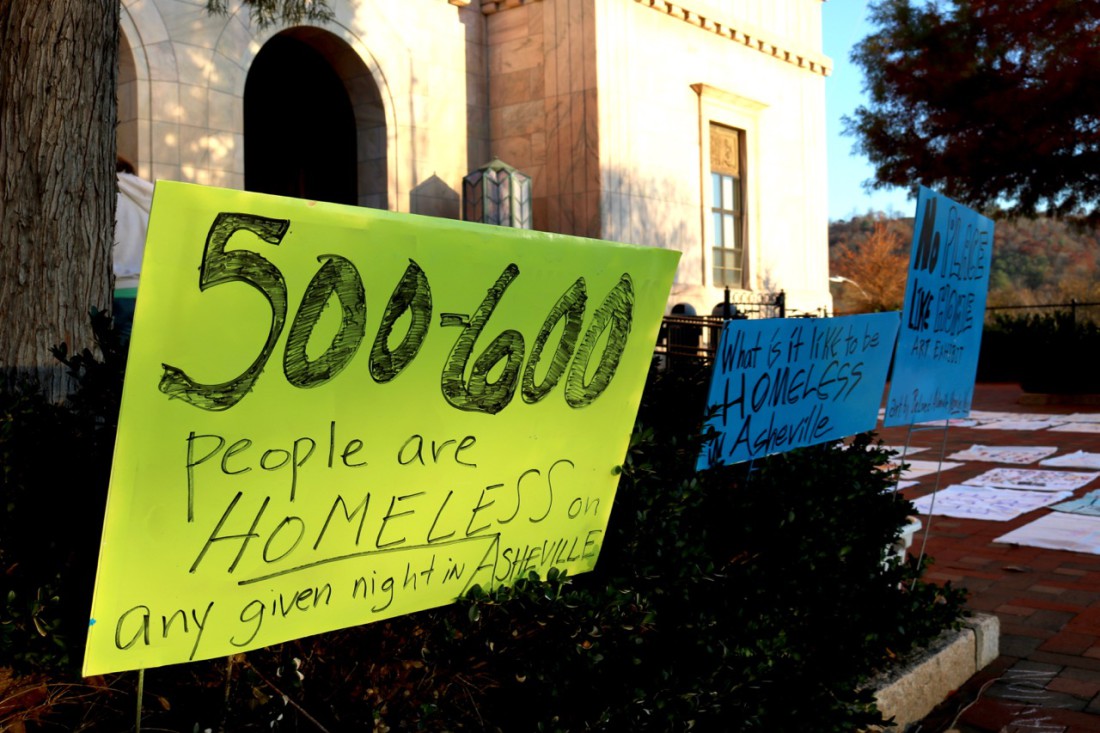
developments with 20% affordable housing should be allowed unlimited unit density. that’s infinity, not 70 units per acre! LaFave could have provided affordable units if he could have built unlimited density! 5% of 10000 units is 500 affordable units! THAT is what should have been permitted! and a tower that high would NEVER flood.
affordable housing is NOT a function of our government. period,
It is if the people elected to form the government make it so, and are elected on that platform. Period.
LOL but the problem is that no one really knows where the money is going. It takes FBI investigations to find out that democrats are spending tax money at Verizon for private phones. Even though they rally around the claims of helping the “poor”.
Government is actively prohibiting affordable housing with its single family zoning, unit density limits, height limits and building codes. If government collapsed all the homeless would immediately build houses for themselves! the 70 units per acre density bonus limit is STILL A GOVERNMENT LIMIT! with no government, there would be no limit as I advocated above.
They don’t want affordability. It doesn’t fit in with the scam of high taxes and corporate cronyism. Go be poor somewhere else is their motto.
Kudos again Lulz!
You should have run for city council on that platform, but I guess shutting up is harder than putting up. But hey, it’s now less than two years until the next filing period.
You should come up with something else. Like go be poor somewhere else. This is Asheville. Where rich sheep come to live in an echo chamber.
The only affordable rental housing project approved by the City in recent years that appears to have substantial merit, IMHO, is the forthcoming apartment block across from the Aston Tennis Courts on Hilliard. The contract promises 50 years of affordability and the City-owned land is leased to the developer who will pay rent. It is a subsidy in that the City could have sold the land or offered a market-rate lease that would generate more money for the City, but at least we have locked in 50 years instead of the more typical 10-15. The Eagle-Market project has been a financial disaster. Lee Walker Heights’ redevelopment looks pretty good on paper—and if it plays out as hoped, it will mark a significant improvement in the Housing Authority offerings. I have been deeply disappointed in the effort to press commercial developers to include a few affordable units for a relatively short span.
As I noted at the meeting, we need housing at all cost levels, and attempting to force affordability is counterproductive. In a flood plain, where the whole structure has to be above projected flood levels, the cost of construction works against affordability in a major way.
You totally failed to offer infinite unit density in exchange for 5% affordable units and persisted in standards that excluded japanese capsules. No wonder you were disappointed! I hope Vijay gives me a pleasant surprise as his campaign was nothing. You campaigned well as so ware a huge disappointment. https://en.wikipedia.org/wiki/Capsule_hotel
The Glen Rock Depot isn’t bad, but I mostly agree with Cecil that the attempt to extrapolate from that to deal with private developers in recent years hasn’t gone well: provide a few “affordable” housing units or put a donation in the swear jar, I mean, Housing Trust Fund. It kicks the can down the road, because the Housing Trust Fund then subsidizes private developers of varying degrees of competence and good faith with limited recourse if things go badly.
Truly affordable housing either needs a broader legal framework with incentives and security for long-term tenancies (the German model) or an approach that literally regards social housing as a municipal asset, operating outside the domain of commercial development. I’d sooner see the Housing Trust Fund (and the bulk of the housing bond money) be spent towards acquiring land and property for long-lease arrangements and essentially taking that property off the market for decades instead of begging for scraps from the table of every single Atlanta/Charlotte/Greenville developer.
Yeah, Cecil is one of council who voted for stealing our taxpayer money to giveaway to the Lee Walker ‘project’ which will forever desecrate AVL. That was $4.2 MILLION stolen from taxpayers and given to the unaccountable criminal entity in this blighted city, the federally funded Housing Authority of AVL. THEN, the effin county commissioners dittoed that with another $4.2 MILLION stolen from COUNTY taxpayers without a vote! Now you know why our local governments are criminal in nature.
And used the money to DEMOLISH scores of affordable housing units when there was plenty of empty space on the parcel for the new and old units both.
Good job on voting to discourage people driving into the RAD. The automobile is a scourge that needs to be contained if we want walkable and bike friendly communities. The Rad is small enough for people to walk around and for various types of shuttle services to be used. Numerous studies show that business increases when streets are designed around people not cars.
LOL, then ban them at the county lines. And let’s see the decadent tourist based RAD go away,.
Good idea I would love to live in a county free of cars. People would adapt by using more active forms of transit and so there would still be a need for the RAD.
Nope. You ban cars and the tourist go byebye. There is no use for the RAD. It doesn’t benefit the people who live here. But it does cost them. Ask any local if they’ll go down the French Broad on a tube. Most WHO HAVE LIVED HERE FOR YEARS won’t go near it. Keep dreaming. As a matter of fact go buy a house and pay the taxes. And them come back and blather on. Cause you ain’t got a clue about the real costs of the area. And the delusions of those in power who waste money to achieve them.
“Cause you ain’t got a clue about the real costs of the area.”
Maybe the self-appointed champion of the working stiff can spell out those costs, so we can all work out whether they’re relevant to actual working stiffs.
Art is not a human need and the combination of starving artists and rich patrons is a recipe for extreme economic disparity. Art is one of the least egalitarian economic sectors, so why progressives seem to like it is beyond me.
City council continues to ENABLE the evil housing authority of Asheville to perpetuate crime and blight all over the city. WHEN will City Council make Gene Bell and David Nash and housing authority ACCOUNTABLE to the taxpayers who must endure all the negative energy caused by segregating the poor ? WHEN will they convert some units to OWNERSHIP and allow the people to PROGRESS like they claim they ‘are’… ? Maybe Donald Trump can help us.
Blight keeps nearby housing affordable. If you pick up litter they will raise your rent! Many public housing dwellers understand this and power to them.
“WHEN will they convert some units to OWNERSHIP”
Never. The city should be looking to buy up property and land when it’s available at below-market rates, for the kind of long-lease management arrangement Cecil Bothwell talked about upthread. Best way to deal with housing segregation is to have city-owned rental property in every community, so that low-income renters have other options than terrible private landlords.
The city has plenty of land already, they only need to be willing to lease ALL land, including parks, for unlimited density affordable HOUSING! The sprawl reduction will help the environment far more than giving up parks will hurt it.
city cannot buy land like that without citizen vote … build your own low rent compound and draw your own poor people…